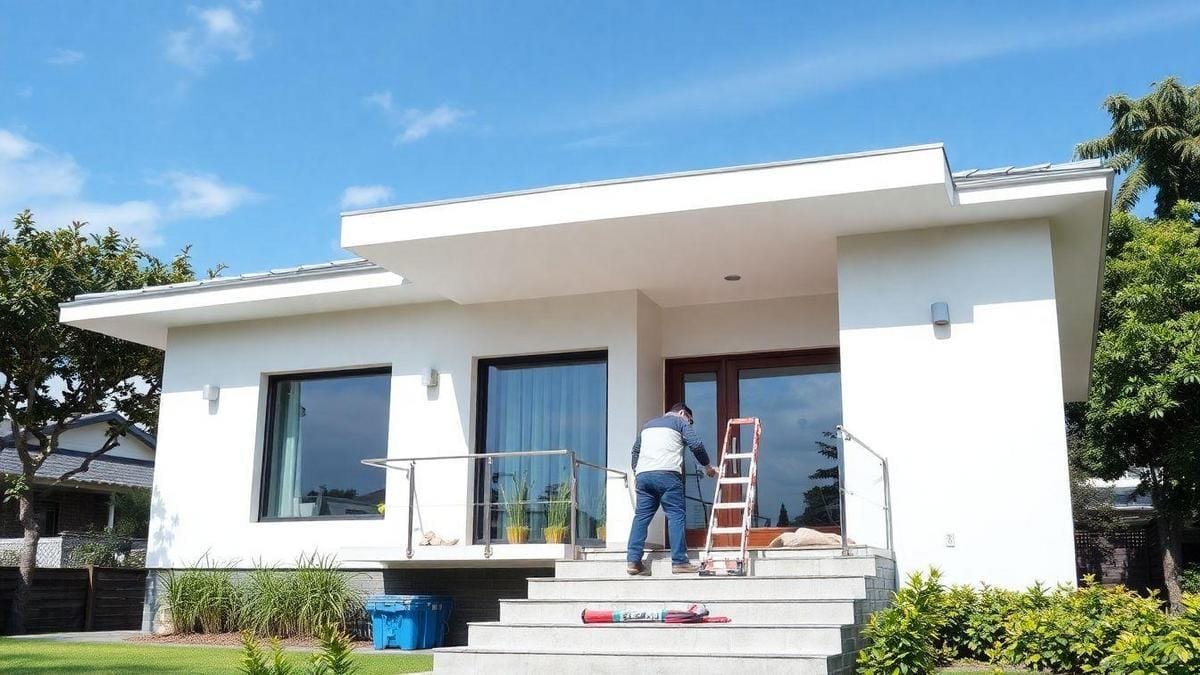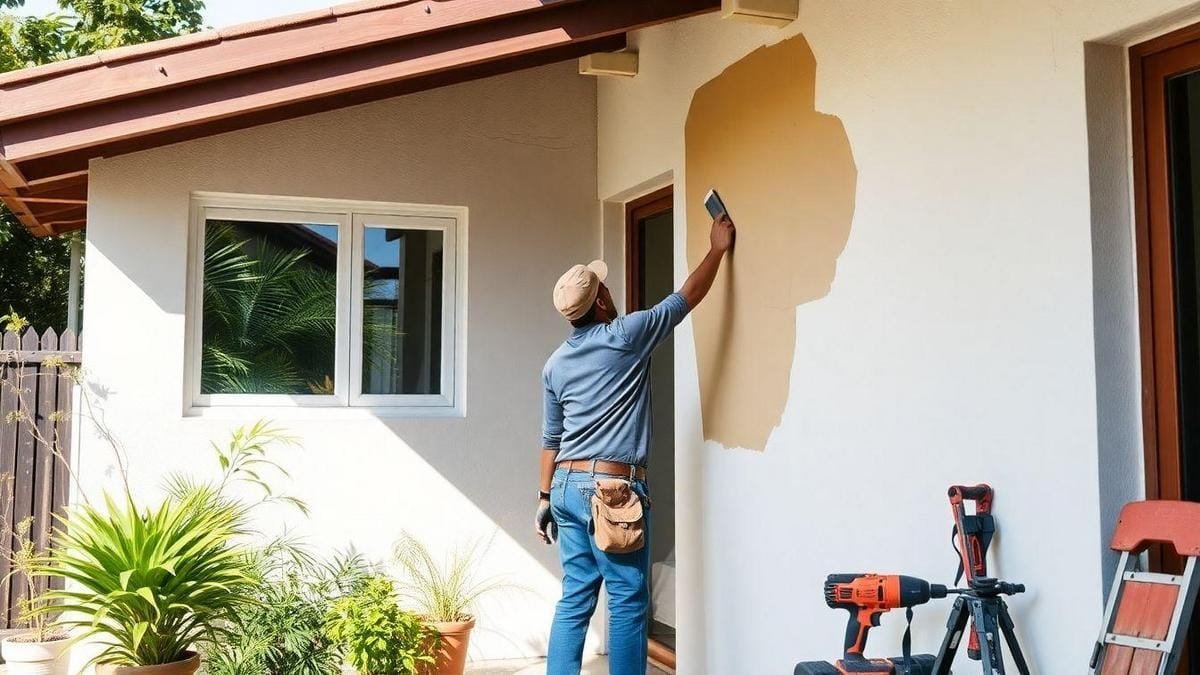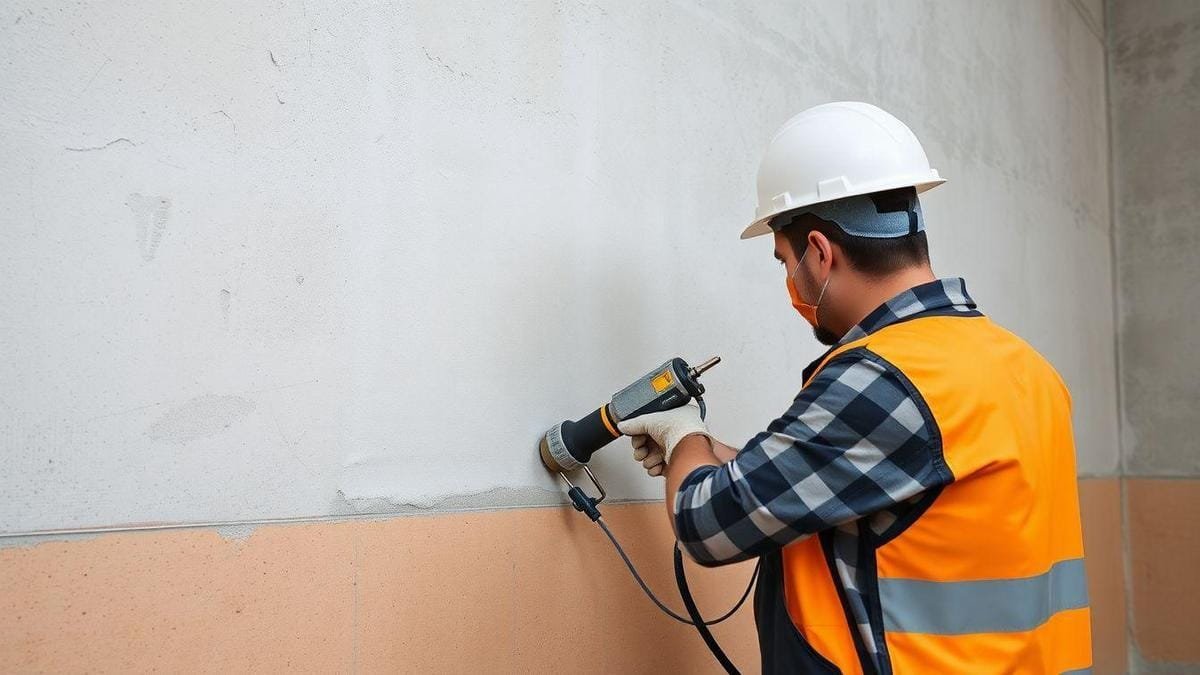Listen to this article
How to waterproof external walls effectively is very important! In this article, you'll find out what the waterproofingwhy it's essential and how to choose the best materials. Let's talk about step by step how to make your walls protected e dry. We'll also give you tips on how to take care of them and know when it's time to do something about them. repairs. Get ready to learn all about maintaining your home safe of water!
Key points
- Waterproofing helps protect walls from water.
- Use special waterproofing products.
- Apply the waterproofing on dry days.
- Leave the surface clean before applying.
- Maintain the waterproofing regularly.

What is external wall waterproofing?
Understanding waterproofing
Waterproofing is like putting a protective cover on the outside walls of your house. Imagine that the walls are like a sponge. If you leave the sponge in water, it becomes soaked and takes a long time to dry. Waterproofing helps to keep water out, so your walls stay dry. dry e strong!
Why is waterproofing important?
Waterproofing is very important because:
- Protect the house of rain and humidity.
- Avoid mold and mildew, which can be bad for your health.
- Increase the life of the walls, making them last longer.
Benefits of waterproofing
Here are some of the benefits of waterproofing:
| Benefits | Explanation |
|---|---|
| Health | Less mold and mildew, which is good for breathing. |
| Durability | Stronger walls that last longer. |
| Comfort | Your home stays warmer and drier. |
| Economy | Fewer repair costs in the future. |
Waterproofing the walls is like giving them a shelter safe for your home. So you can play and live happily without worrying about water!
Materials for waterproofing external walls
Types of waterproofing materials
When you want to protect the walls of your home, there are various materials that can help. Here are some of the most common:
- Asphalt blanket: It's like a thick blanket that covers the walls. It helps to stop the water.
- Liquid coatingsThey look like paint. You paint them on the walls and create a layer that won't let water through.
- Waterproof cementsThese are special and help to keep water out of the concrete.
- GeotextilesThey are like fabrics that help drain water and protect the walls.
How to choose the right material
Choosing the right material is very important! Here are a few tips to keep in mind:
- Where you liveIf it rains a lot, choose a stronger material.
- Wall type: Some walls need different materials. Ask an adult which is best for your home.
- Cost: See how much you can spend. Sometimes it's better to spend a little more to get something that will last.
Comparing materials
Here's a table showing how the materials compare:
| Material | Cost | Ease of use | Duration |
|---|---|---|---|
| Asphalt blanket | High | Difficult | 10 years |
| Liquid coatings | Medium | Easy | 5 years |
| Waterproof cements | Bass | Medium | 7 years |
| Geotextiles | Medium | Easy | 5 years |

Step by step for waterproofing external walls
Preparing the wall before waterproofing
Before you start waterproofing, you need to prepare the wall well. This is very important! Here are the steps:
- CleaningUse a brush to remove dirt and dust. If there is mold, use water with a little soap.
- RepairsCheck for holes or cracks. Use wall putty to fix everything.
- DryingWait for the wall to dry thoroughly. This can take a few hours or even a day!
Applying the waterproofing material
Once everything is clean and dry, it's time to apply the waterproofing material. Follow these steps:
- Choice of material: Buy a good waterproofing agent. Ask at the store if you don't know which one to choose.
- ApplicationUse a roller or brush. Apply a thin, even layer to the wall.
- DryingWait for the first layer to dry before applying the second.
Tips for a good result
Here are some tips to give you an incredible result:
| Tip | Description |
|---|---|
| Do it on a sunny day | The sun helps it dry faster! |
| Wear gloves | Protect your hands from the product. |
| Read the instructions | Always follow the instructions on the packaging. |
External wall waterproofing techniques
Blanket waterproofing method
When we talk about waterproofing of external walls, one of the most effective methods is the use of blanket. Imagine that the blanket is like a covered which protects your wall from water. It's made of a special material that won't let water through. To use the blanket, you need to put it on the wall before finishing. This helps to keeping the house dry and mold-free.
Use of sealant for external walls
Another technique is to use a sealant. The sealant is like a adhesive that you put on the wall. It fills in all the holes and cracks, preventing water from getting in. You can use the sealant on walls that have already been painted or plastered. It's very easy to apply and you can even do it with the help of an adult. Sealant is great for those who want quick and effective protection.
Advantages of each technique
| Technique | Advantages |
|---|---|
| Manta | Long-lasting, water-resistant protection. |
| Sealant | Quick and easy to apply, ideal for small cracks. |

Maintenance of waterproofed walls
How to take care of waterproofing
Taking care of waterproofed walls is like looking after a new toy. You want it to last a long time, right? To do this, it's important to do a few things:
- Regular cleaning: Use soap and water to clean the walls. This helps to remove dirt and dust.
- Check the joints: Check that the parts where the walls meet are sound. If there are holes or cracks, it's time to fix them.
- Reapply waterproofingAfter a few years, it may be necessary to reapply the waterproofing product. Ask an adult when the time is right!
Signs that waterproofing is in need of repair
Sometimes walls can show signs that they need help. Here are a few things you should look out for:
- Moisture stainsIf you see dark spots or bubbles, this could be a sign that water is getting in.
- CracksIf the walls have cracks, this can allow water to pass through.
- Musty smellA bad smell can indicate that water has accumulated somewhere.
Tips to prolong durability
Here are some tips to help your walls stay looking good for longer:
| Tip | What to do |
|---|---|
| Avoid too much water | Don't let water accumulate near the walls. |
| Use suitable products | Always choose products that are good for waterproofing. |
| Do maintenance | Take a look at your walls from time to time to make sure they're okay. |
Waterproofing in buildings
Importance in new construction
When you build a house or a building, waterproofing is like putting on a protective cover. This cover helps to protect the walls and floor from water. If water gets in, it can cause problems such as mold and mildew. Nobody likes to have a place that smells bad or looks dirty, do they?
Think of waterproofing as a superhero that defends your home. It's super important because it keeps everything dry e healthy. So you and your family can live happily and peacefully.
How to waterproof renovations
If you already have a house and want to renovate it, you can also waterproof it! It's like putting a new coat on something that's already old. Here are a few simple steps:
- Cleaning the areaRemove everything that is on the wall or floor.
- Repairing cracksIf you see any cracks, it's time to fix them. This helps keep water out.
- Apply the productUse a special waterproofing product. Follow the manufacturer's instructions. It's like following a cake recipe!
- Wait for it to dryAfter applying, let it dry well. This is very important!
Examples of success in waterproofing
Here are some examples of places that have been waterproofed and look great:
| Location | Results |
|---|---|
| Maria's House | No mold or bad smell! |
| João's building | Happy dry walls! |
| Ana's School | Students learning without problems! |
These places showed that waterproofing is a good idea. Now they are protected e beautiful!
Conclusion
Now that you've learned about waterproofingIf you're a homeowner, you know how important it is to protect your walls from water. With the tips and steps we've discussed, you can make your home dry e healthy. Remember to take good care of them, as if they were a new toy! And don't forget, if you need more information, just visit the website Renovation Tips to discover more secrets on how to keep your home beautiful and protected!
Frequently asked questions
What is external wall waterproofing?
Waterproofing is when you protect the outside walls of the house from water.
Why do I need to waterproof external walls?
Water can cause mold and damage walls. Waterproofing helps keep your home healthy.
How do I know if my walls need waterproofing?
If you see stains or bubbles, your walls probably need waterproofing.
What materials do I need to waterproof walls?
You'll need waterproof paint, a roller or brush, and sometimes more things like mortar.
How to waterproof external walls effectively?
Use waterproof paint in layers. This helps to cover the wall well.
How long does it take to waterproof walls?
It usually takes a day or two. But it can take longer if the wall is badly damaged.
Is it necessary to prepare the surface before waterproofing?
Yes! Clean the wall well so that the paint sticks. And wait for it to dry!
Can I do the waterproofing myself?
Yes, you can! There's no one better than you to take care of your home.
How often do I need to waterproof the walls?
Every 3 to 5 years. This keeps everything in order.
Can waterproofing help on rainy days?
Yes, waterproofing will help your home stay dry even when it rains a lot.
Where can I buy waterproofing materials?
You can buy it in building materials stores or online. It's easy!
What to do if the waterproofing doesn't work?
If it doesn't work, call a specialist. They know how to solve it.
Is waterproofing expensive?
It depends! It can be cheap or expensive, but it's a good investment for your home.

Adalberto Mendes, a name that resonates with the solidity of concrete and the precision of structural calculations, personifies the union between engineering theory and practice. A dedicated teacher and owner of a successful construction company, his career is marked by a passion that blossomed in childhood, fueled by the dream of erecting buildings that would shape the horizon. This early fascination led him down the path of engineering, culminating in a career where the classroom and the construction site complement each other, reflecting his commitment both to training new professionals and to bringing ambitious projects to fruition.

